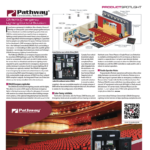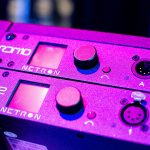 Madrix has long been known for its powerful and easy to use LED pixel mapping control software. But last year at LDI, I spotted some new hardware pieces designed for use with Madrix as well. Since these hardware devices have each been designed to handle a respective portion of the shared task of pixel and voxel mapping of LED fixtures, I decided to take a closer look at them to get a better understanding of how they fit into a system design.
Madrix has long been known for its powerful and easy to use LED pixel mapping control software. But last year at LDI, I spotted some new hardware pieces designed for use with Madrix as well. Since these hardware devices have each been designed to handle a respective portion of the shared task of pixel and voxel mapping of LED fixtures, I decided to take a closer look at them to get a better understanding of how they fit into a system design.
The four devices I’ll be reviewing in this article are: (1) Madrix Luna 16, an Art-Net distribution node that controls up to 16 DMX universes; (2) Madrix Plexus, a standalone SD card controller for two DMX/Art-Net universes; (3) Madrix Nebula, an LED pixel tape driver that controls multiple supported SPI protocols, and (4) Madrix Stella, a 2-port Art-Net node or DMX 512 USB interface.
Madrix Luna
The demo unit I received was the Madrix Luna 16, a member of the Luna product line that also includes the Luna 8 and the Luna 4. The Luna 16 hardware is available in 2RU size with 16 configurable XLR female (DMX Out) ports and 1 configurable XLR male (DMX In) port, and it can connect to a computer running Madrix either via Ethernet or USB 2.0. When the Luna (or any of these devices) are connected to Madrix, the software can auto-sense the connected device(s), making configuration fairly easy.
Four key features to note about the Luna include: (1) Luna can be used as an Art-Net node with other consoles, controllers and software if desired; (2) HTP Merging for 2 Art-Net sources is built-in; (3) Sync mode is built into all Madrix hardware and software, allowing Art-Net data for all output ports and/or multiple devices to be synchronized for optimal playback performance, and (4) Luna can also be configured directly via a web configuration tool. This can be handy in applications where the Luna is operating as an Art-Net distribution node in a system for an Art-Net source other than Madrix.
While working with the Luna, I was able to set it up and test most of these features, with the exception of the Sync mode. And, despite requiring a little assistance with the DMX Input configuration, when DMX Input is properly configured, it allows the main “Live” features of the Madrix software to be controlled remotely from a lighting console (Live features refer to such tasks as controlling the master, effect switching via storage bins, speed masters, etc.).
Although the Luna is a powerful Art-Net distribution node that can be used with third party Art-Net controllers, it seems that most users are likely to spec it for use within a Madrix based controller system, and they will be very happy in doing so. Configuring it to work with Madrix is simple, and Madrix software settings make configuration practically automatic. If your project involves large numbers of LED fixtures and pixel mapping, then this would definitely be a solid data distribution node to use.

Madrix Plexus
This is a small handheld controller that unlocks 1024 DMX channels when connected to Madrix that can be used as either a Live controller (in conjunction with a computer running Madrix) or a Stand-Alone playback unit (running scenes stored on an SDHC card created in Madrix show file). It automatically includes the required Madrix software license for this number of channels and does not require a separate license for Madrix.
It features an on-board event scheduler and a master-slave sync mode between multiple controllers, which would be handy if your show required more than two universes of DMX and you had to use more than one Plexus.
Although it can be combined for use in live control setups with Madrix or third-party Art-Net controllers, Plexus is primarily intended to be used as a stand-alone controller, making it practical in semi-permanent applications such as clubs, retail, businesses and architectural installations. It can be triggered remotely as well as via time-control and/or automatic playback, and its SD card storage means you can program the show on the Plexus with Madrix and then leave the Plexus behind for control, making it more cost effective than a Madrix license left running on a computer in a storage closet in the back.
While exploring the onscreen menus of the Plexus, I found the menu to be simple to scroll through. Many of the options featuring a “pencil” icon, which lets users edit directly on the Plexus screen. Also, if desired, the web configuration page also includes an “Edit” button to provide similar edit functionality.
One hardware-related detail I noticed is that while the DMX ports and Ethernet port all feature locking Neutrik connectors, the power cord is an adapter that connects via USB. This seems like it could be easily pulled out, because it does not lock.
Overall, the Plexus seems like a handy controller designed for architectural, office, retail, or club based installations, without being too large or complicated to use.

Madrix Nebula
The last two devices I received for evaluation were the Nebula and the Stella. Both boxes are primarily designed for installations or non-touring type applications involving LEDs, and each box can be powered via USB, or 5V to 24V over a 2-pin screw terminal. Aside from the size and installation specs, these two boxes perform very different functions in a Madrix control-based LED system.
The Nebula is an Art-Net to SPI converter/pixel tape driver that allows incoming control data over USB or Ethernet to directly control connected LED pixels. No other interface is required between an Art-Net source and the Nebula. With two configurable ports, each Nebula can control up to 680 RGB LEDs per port (combined total 1,360 RGB pixels per Nebula or 2,048 single channel LEDs). While the Nebula can be used with any Art-Net source, it’s primarily designed to be used in a Madrix based control system for ease of configuration and use. And, the Nebula currently supports more than 30 types of LEDs, making it one of the few devices on the market that supports the most number of LEDs currently available.

Madrix Stella
The Stella, also a type of Art-Net/DMX/USB interface device, is a control interface for use in permanent installations, similar to the Luna in many ways. As an Art-Net node, it is meant to be used in conjunction with Madrix for DMX output to LEDs but in a more permanent installation market. It can be configured for two DMX universes of input and/or output, without the need for XLR connectors, and several boxes can be combined for more universes, while the built in SYNC mode ensures that all boxes will remain synchronized during playback.
Just as the Luna has built-in HTP Merging and compatibility with third party Art-Net controllers, so does the Stella, and it, too, can be configured via a web configuration tool, just as the Luna.
Both the Stella and the Nebula offer data distribution solutions in a Madrix-based LED control system. As such, using all Madrix products in an installation makes total sense from a stability perspective. In fact, I can see these devices being specified on the majority Madrix projects due to their ease of installation, configuration and use. And, while I don’t know if the majority of applications using third-party Art-Net controllers will immediately jump on board and use some or all of these products, the fact that Madrix built in the flexibility to be able to be used with any Art-Net source makes it theoretically possible. And despite a few bumps along the way in the configuration setup when not using Madrix, I think these network devices are simple enough to use and could easily find themselves being specified into some installations where other products may not have the same flexibility and ease of use.
At a Glance:
A Hand-in-Glove Fit
If the goal of total system stability is a big priority — and it probably always should be — it makes sense to pair up Madrix software solutions for LED pixel mapping control with the company’s various hardware devices. They have been designed to work as components in a total system solution, with varying options designed to meet a wide range of uses and needs.
Madrix Hardware Options
Madrix Luna 16
This Art-Net distribution node controls up to 16 DMX universes. The Luna 16’s MSRP is about $1,700 (1,200 Euros). Madrix also offers the Luna 8 and Luna 4.
Madrix Plexus
The Plexus is an SD card controller for two DMX/Art-Net universes. It can be used as a stand-alone controller, or in conjunction with a computer running Madrix. MSRP: About $1,400 (900 Euros).
Madrix Nebula
The Nebula is an Art-Net to SPI converter/LED pixel tape driver that allows incoming control data over USB or Ethernet to directly control LED pixels. MSRP: About $465 (300 Euros).
Madrix Stella
The Stella is also a type of Art-Net/DMX/USB interface device, similar to the Luna and suited to permanent installations. This 2-port Art-Net node or DMX 512 USB interface retails for about $550 (325 Euros).
Manufacturer: Madrix
More Info: www.madrix.com


